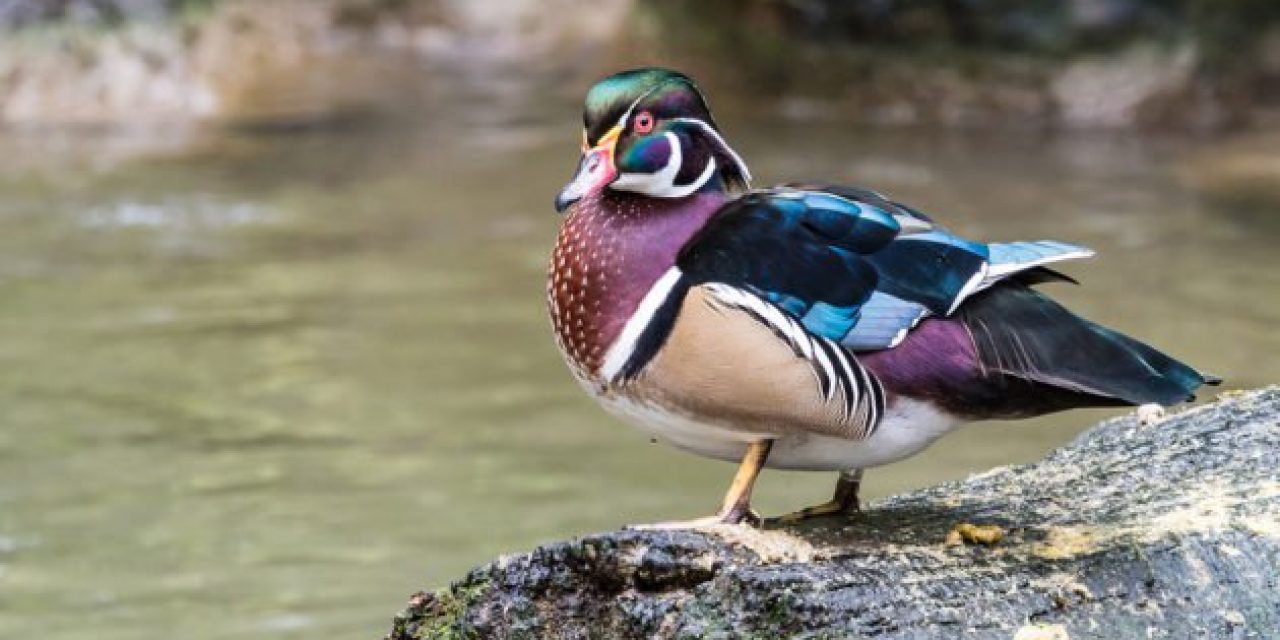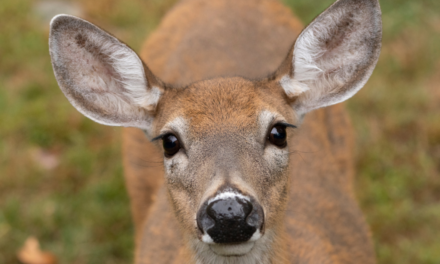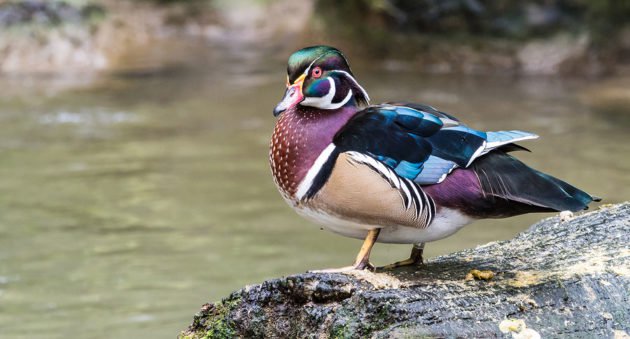
Here are all the species of duck you can hunt here in America.
Waterfowl hunting seasons have either begun or are set to start soon in many areas across North America. Duck hunters are all set to head to the lakes and fields in pursuit of their favorites.
Duck hunting is an awesome way to spend time afield and fill your freezer in the process and we’ve put together an extensive waterfowl identification guide to help you ID the different species in the field.
We’ll tell you everything you need to know for duck hunting about the most popular huntable game birds here in the United States and Canada.
Mallards
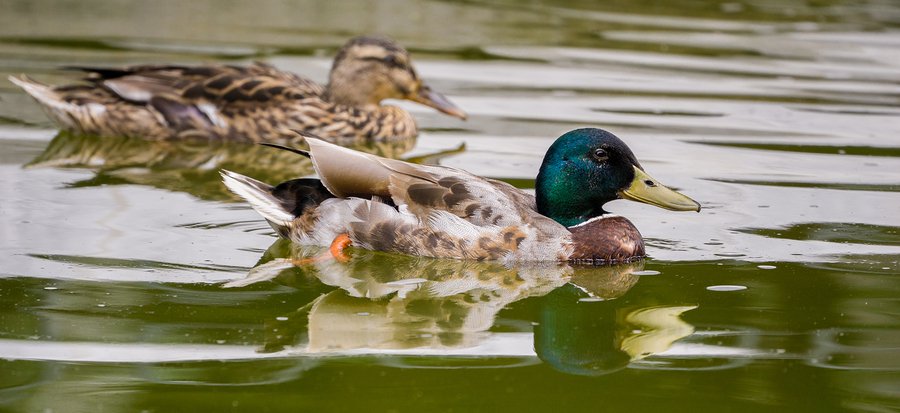
We’ll start off with a classic and arguably the most popular species of dabbling duck to hunt in the world, let alone North America. Mallards are dabbling ducks. Almost everyone, even non-hunters recognize the drakes, which have a distinctive green head. Hens are a little bit drab in comparison. They are mostly brown. Although the speculum is also distinctive for both sexes. It is either iridescent blue or black, ringed with a black and white border.
Mallards are found throughout Canada, the lower 48 states and even parts of Alaska. No wonder they’re so popular with North American waterfowl hunters. This is one of the most adaptable species of duck out there, thriving in both your usual swamps and wetlands and urban environments. This is a species you’ll often see in big city parks all over the world. I visited London, England this past summer and saw these ducks hanging out all over in the parks there. The mating season for mallards runs around October and into November, which is about the same time most hunting seasons run. Nesting happens in the spring.
As we noted earlier, this is a dabbling species that eats mostly subsurface plants, although there are reports of them preying on small animals on occasion. This species responds well to calls and decoys. In fact, you can often use mallard calls and decoys to great effect on some other species on this list, too!
Wood Ducks
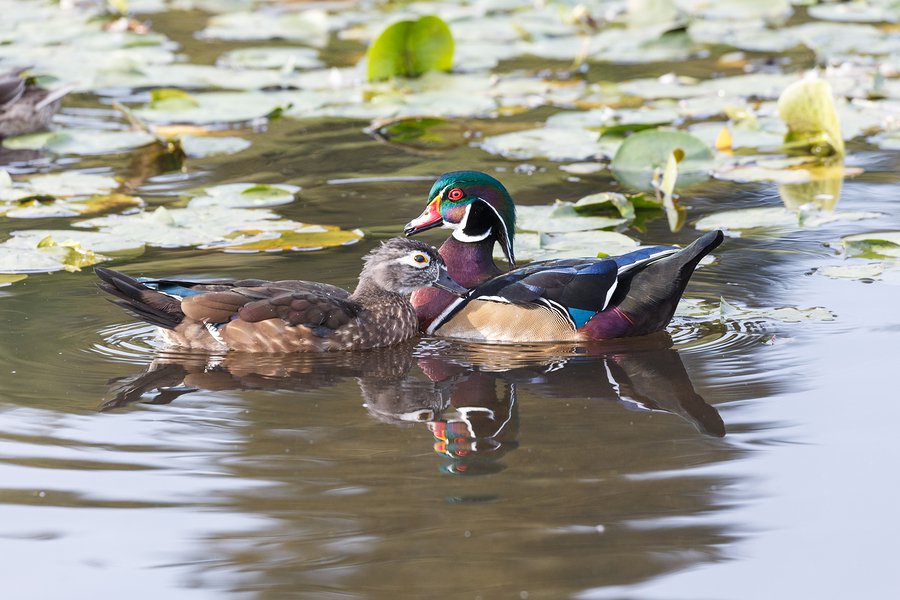
While mallards may be one of the most commonly hunted species, wood ducks are probably one of the most coveted in North America. That’s because the males are arguably one of the most beautiful birds in the world. The drakes are covered in distinctive iridescent red, blue, black, tan and white feathers that form distinctive and beautiful patterns all over the animal’s body. To top it all off, the males have red eyes, making them even more eye-catching. There’s a reason why many a hunting cabin has at least one mount of this species to brighten things up!
Much like the mallards, the hen wood ducks are rather dull and unexciting, at least by comparison. Of course, that doesn’t mean they aren’t great eating, but they’re mostly grey with some white highlights. The females do often have a little color on their speculum in the form of an iridescent blue.
The range for wood ducks is somewhat spotty in North America. There are year-round ranges on the West Coast and through much of the Southeastern United States. They are found in the Midwest, but mostly during the breeding season. Spotty populations sometimes show up in Western states. This is an omnivorous bird, but they eat mainly berries and acorns.
The beautiful look of this duck means it was once nearly hunted to extinction for its feathers. This animal is one of the great success stories of conservation in the modern era of hunting. Probably the only other animal to make a bigger comeback is the wild turkey. While wood ducks have made great progress, it’s still making a comeback in some areas, which is why the bag limit per day is often quite small.
Teal
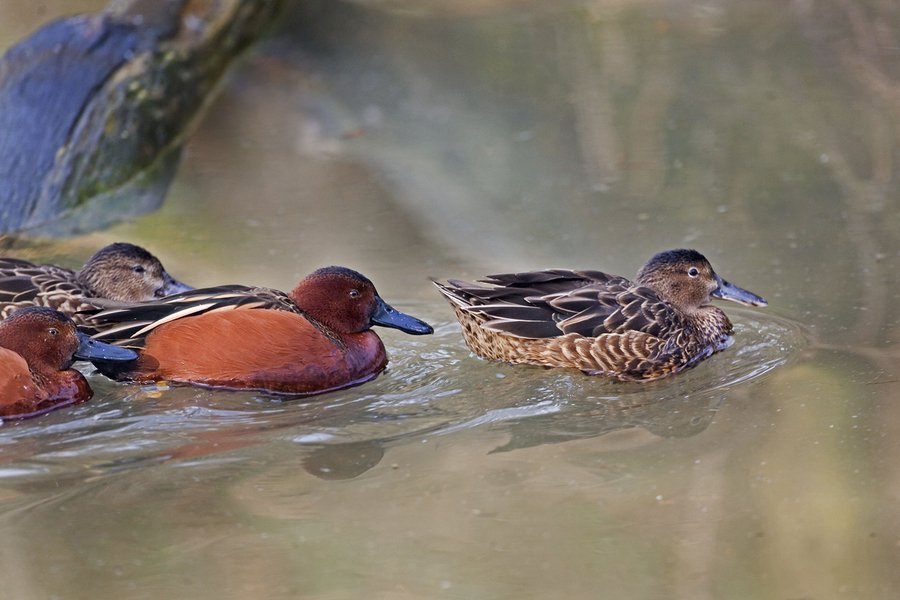
There are three different varieties of teal ducks that are popular to hunt. We’re going group them together to save time. The three species are bluewings, green-winged and cinnamon teal. These are dabbling ducks with a diet that consists mostly of underwater foliage and the occasional small animal in the backwaters and bogs they like to call home.
Teals are distinctive in that they are among the first species to migrate every year. These are often the first birds most hunters target every year as they make their way to winter ranges in South and Central America. The seasons are short and sweet, sometimes no more than a week in length.
As for physical differences, cinnamon teal are just like the name describes. Males are a sandy, cinnamon-brown coloration with red eyes and dark beak. Females are a more muted grey with white highlights, dark eyes and a dark beak.
Blue-winged teal are slightly more colorful. The distinctive feature here is a bright white shape on the head between the beak and the eye. The body is mostly brown with patches of dark blue plumage on the tail. Females are mostly brown.
Green-winged teal are among the prettiest of the bunch. The males have brown heads with a distinct band of green iridescent plumage running back behind the eye. The body is usually grey with black and green plumage on the speculum. Exercise some caution when hunting any teal. The hens are often brown and sometimes look nearly identical to mallard hens. It doesn’t help that most teal respond well to mallard decoys and calls, either.
These birds do most of their nesting in Canada, but there are pockets of year-round populations in some Western states and New England.
Northern Pintail
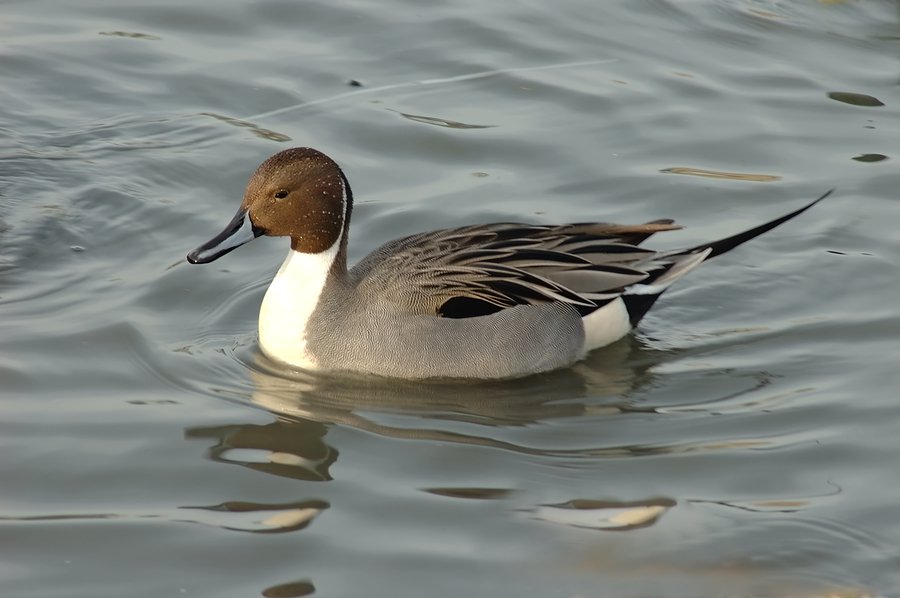
Drake Northern Pintail ducks are extremely popular with hunters for their gorgeous black, grey, white and brown plumage. If there was ever a duck that looked like it was going to a fancy black tie event, it would be the pintail. Like the other ducks on this list, the hen is a more muted light brown and white, but still carries a bit of elegance all her own.
Pintails are dabbling ducks that will eat the occasional insects or other small creatures when the mood strikes them. These puddle ducks are fast birds with a range that extends over much of North America for at least part of the year. These ducks beloved by migratory bird hunting enthusiasts all over the world. As crazy as it seems, this species sometimes flies across oceans! Birds banded in one part of the world have occasionally been shot on an entirely different continent!
The pintail duck breeds in the spring and early summer and nests in July. Unlike many other species of duck, they prefer waters without timber. Some hunters like to target pintails at the same time as mallards. Texas is generally considered one of the premiere destinations to hunt these birds.
Canvasbacks
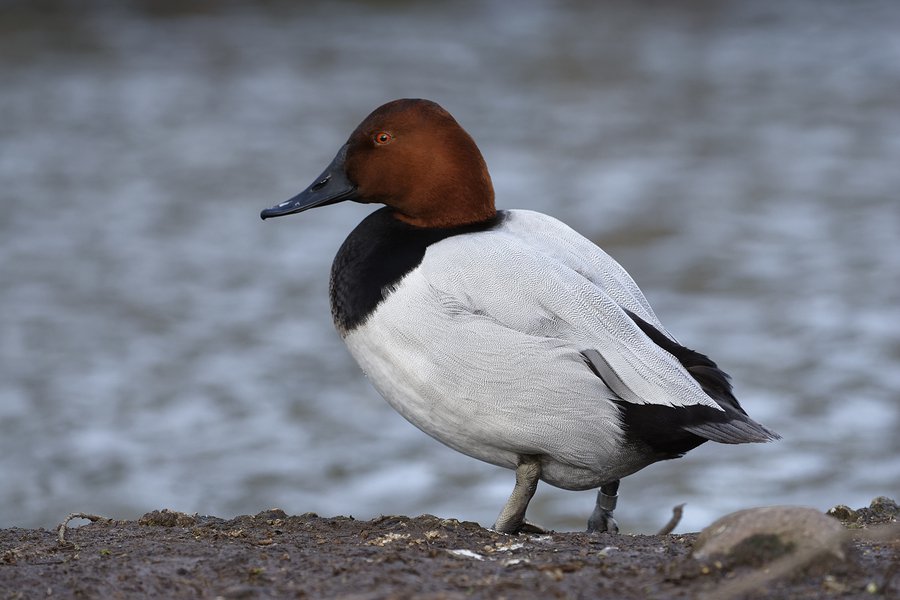
This diving duck is sometimes referred to as the “white-backed duck,” but here in North America most hunters will know what you’re talking about if you say canvasback. These birds spend time throughout much of the United States, but you’ll often hear them talked about in conjunction with the Chesapeake Bay, where legendary numbers of them once lived or the Mississippi River.
Canvasbacks are huge for ducks. It isn’t uncommon for a drake to weigh over three pounds. The males are distinctive with their white backs, which to the first European settlers of America to see them, looked like canvas. Hence the name. The head and neck are a combination of brown and dark black or blue-grey. One interesting feature is that the eye changes color depending on the season. During the spring there is no mistaking the bright red color. This color changes to a duller tone in winter.
Hen canvasbacks are mostly grey with a lighter-colored head and dark eyes. Both sexes have dark-colored bills. This duck has a varied diet. But they seem to prefer either wild celery or certain species of pond weed. Hunting them is often a challenge. As large as they are, they are extremely fast and seem to respond best to large setups of a hundred or more decoys. Bring some friends to help with setup!
Redhead Ducks
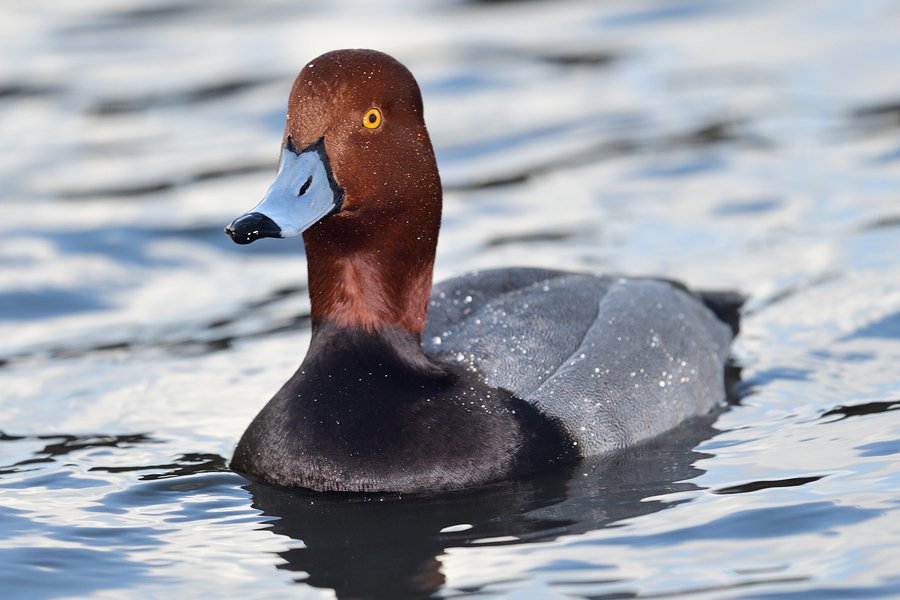
Everyone has heard of redheads. After all, they’ve got a whole line of outdoor products named after them! And it’s not just products for duck hunting, either. Redheads are diving ducks are found all over North America and eat a varied diet of both small invertebrate animals and a variety of plants.
These birds prefer wetland areas for most of the year, but during the winter months they are likely to be found near larger bodies of water. Many like to spend the cold winter months near the Gulf of Mexico.
There is no mistaking a redhead drake during the breeding season. It has a distinctive red or copper-colored plumage and a black chest and tail. For much of the rest of the year, the drake’s head is a brown color. Hens vary in color between yellow, grey and brown for most of their body, but their feathers never change colors. The neck is usually a more distinct lighter color. The bill for both sexes is a blue or grey in color with a distinct black tip.
Much like with canvasbacks, Texas is considered a destination spot for hunters seeking out large numbers of redheads.
American Black Ducks
These ducks have a slightly narrower range than many other species on this list. Black ducks are mostly found in states and provinces east of the Mississippi. Despite this, the dabbling duck is extremely popular with waterfowl hunters. This species is very similar to the mallard and the two species do interbreed on occasion.
This bird eats both aquatic plants and land grass. This is another species you must be careful hunting because both males and females can closely resemble hen mallards. The main difference is that black ducks have a much darker plumage. The biggest difference you’ll often see between the two genders is that drakes have yellow bills while hens have green or dull yellow ones.
This species is found in a variety of habitats. You’ll find them in boggy backwaters, but also in large coastal areas at times. This species has a widely varied diet. They eat everything from aquatic and terrestrial grasses to small invertebrates and even small animals at times.
Bag limits for black ducks are often very low because the number of black ducks seems to be dropping. This species has suffered some habitat loss, but another factor blamed by many hunters is that interbreeding with mallards we mentioned. While they aren’t considered a threatened species, they are one that state wildlife agencies and biologists are keeping an eye on for now.
Gadwall Ducks
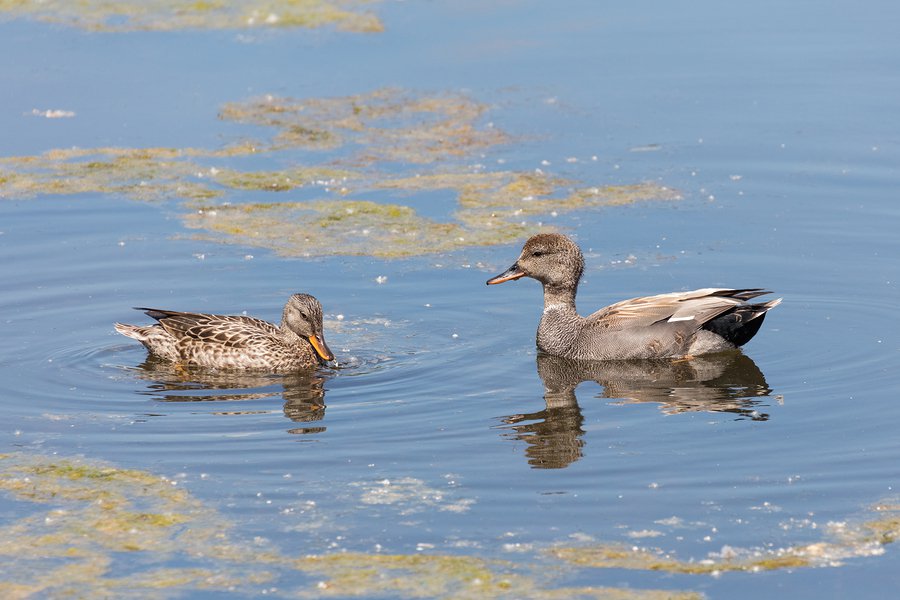
This is another species that has a distribution all over the world and not just North America. Gadwalls are mostly grey or brown in color. The hens often have more of a “mottled” appearance in plumage than the males. Males have dark tails and white speculums. Another quick way to tell them apart is that males usually have much darker bills. Females often have distinct orange bills.
This is a dabbling duck species that seems to prefer open wetland areas. This species seems to be steadily increasing in numbers and expanding its range. Good news for hunters! Millions of these ducks are already harvested every year.
These ducks are sometimes hunted in conjunction with wigeons. You’ll get some varying opinions on how they are as table fare, but they are considered a fairly easy species to decoy as they don’t group in huge numbers like many other species tend to do.
American Wigeon
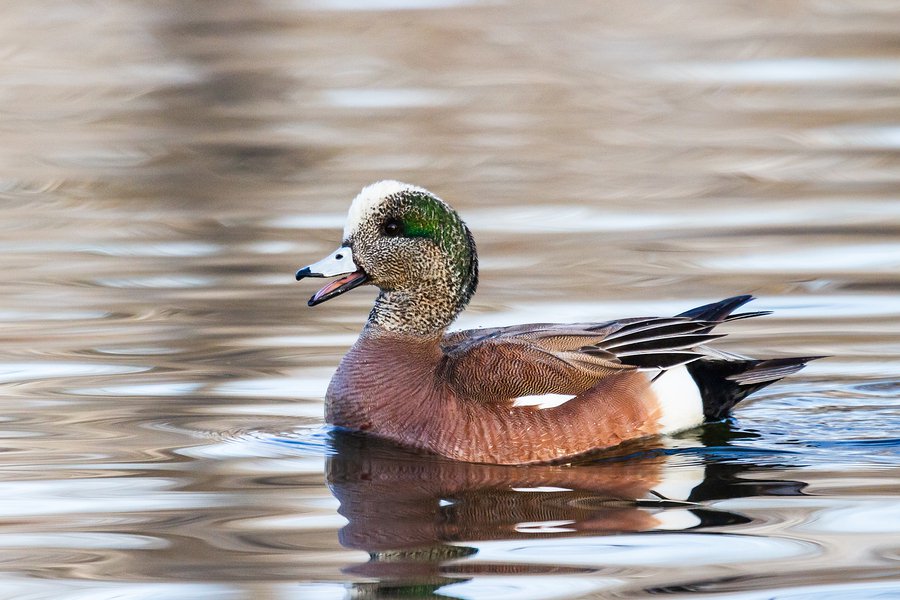
Wigeons are a highly hunted species, but they just aren’t a household name like mallards or wood ducks. Wigeons breed in Canada and Alaska. However, they spend much of the rest of their time in coastal regions and southern states. There are many different varieties of wigeon throughout the world, but the American wigeon has a very distinctive appearance.
The drakes have a distinct white or grey and green head and a brown or grey body and white belly. Hens are mostly grey or brown in appearance. The bills of these birds are distinctly short, with a grey or blue-grey color and a black tip.
These birds have a diet that consists mostly of aquatic plants and small invertebrates. Strangely enough, there aren’t a ton of wigeon decoys on the market these days. But it doesn’t really matter, if you can find an area where these birds are hanging out, chances are you can bring them in with a variety of decoys of other species.
Eider Ducks
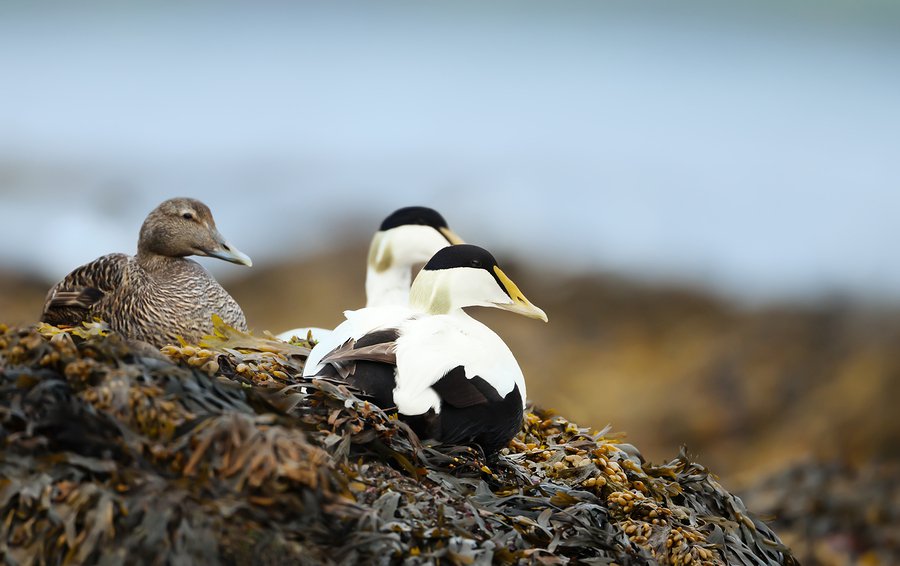
There are two subspecies of eider or “sea duck” that are popular in the United States, the Common Eider and the King Eider. Unfortunately for most waterfowl hunters, the populations are clustered in New England and Alaskan coastal areas.
Both species are extremely large ducks. Common eider drakes take on a beautiful black and white plumage during the breeding seasons. Hens have a more muted grey and white appearance. One thing that really sets the appearance of these ducks apart is the huge head and wedge-shaped bill.
King Eiders drakes also have striking black and white plumage but the thing that really sets them apart is the head and bill. They have a pale blue head with hints of blue-green, yellow and black. The bill is red. Female King Eiders are a brownish color.
Both varieties of Eider grow huge. Specimens close to 5 pounds are not uncommon. These birds spend much of their time at high northern arctic climates before nesting in areas of New England during the warmer summer months. Because of the limited distribution and unusually large size and coloration, these birds are a buck list item for many waterfowl hunters.
Common Merganser
There are a few different varieties of this bird, including the red-breasted merganser. But we’re only going to cover the common merganser because this isn’t a hugely popular species to hunt. Mainly because these ducks aren’t considered to be great table fare. These ducks have a distinct crest of feathers on the back of their head they can extend.
The head of a breeding drake is usually a dark black. The body is mostly white with white and black wings. Females are usually a grey color with a brown head.
This is largely a predatory species, which may explain why it’s not as tasty as some other species. They like to eat fish, mice and other small animals and even other birds at times. This species is also known to spend some time in saltwater.
The common merganser is found throughout the northern United States for at least part of the year. They nest in Canada, but there are year-round populations in the Northeast and Northwestern parts of the U.S.
These birds aren’t found in most southern states.
Northern Shoveler
Another species that isn’t quite as popular among hunters. It’s easy to see where this species got its name when you see the huge, shovel-like beak. There are a few different subspecies out there, but the Northern Shoveler is the one you’ll see discussed most often.
Females have a typical, drab appearance. Again, they look a lot like mallards. Thankfully the huge, distinctive bill helps pick them out. Drakes on the other hand have some great coloration that makes them even more distinctive. Males usually have an iridescent green head. Their wings are flanked with similarly iridescent green and blue plumage accompanied with a white stripe. The beak is dark.
Shovelers are omnivores. They’ll eat aquatic plants like many species of duck, but they also like to feed on invertebrates, using that big, distinct bill to find plankton and other small sea creatures to eat. This species gets something of an unfair reputation as a “trash” species, but you’ll find there are dedicated shoveler fans who have carved out a small niche on the Internet.
Greater Scaup
This diving duck is also sometimes known to hunters by the nickname “bluebill.” This is a gorgeous animal. The drakes have green or black-colored heads, a black breast and tail and grey and white wings. Females are a muted brown in color and both sexes have a distinctive blue bill, thus the nickname.
These ducks are distributed mostly to Alaska, the West Coast and coastal waters from Maine to Mexico. But they are also found in the Great Lakes. These birds are also omnivorous, consuming a diet of plants, mollusks and small water invertebrates. These birds breed and nest in high northern areas of the tundra.
This species, much like the American green duck, has seen something of a population decrease in recent years. Albeit, for differing reasons. One of which is the explosion of invasive zebra mussels in the Great Lakes. Scientists recently discovered scaup eating the zebra mussels were also ingesting a chemical element that was effectively causing sterilization in some animals. There is one more reason to check your boat for invasive species after every hunting or fishing trip!
Ring-Necked Duck
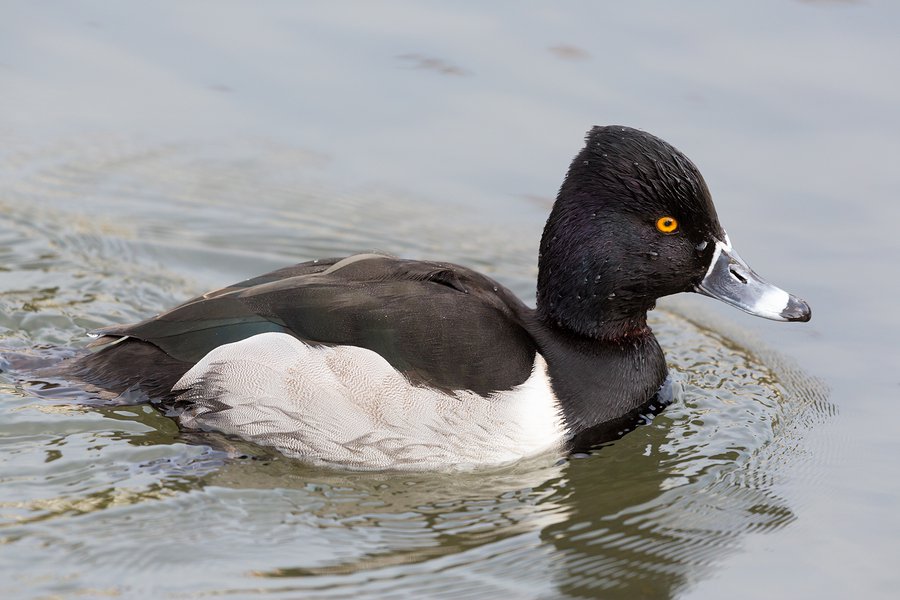
This species has a similar appearance to the greater scaup. Drakes have a distinctive black head with a white, black and grey beak. A cinnamon-colored neck ring on the males is where this species gets its name. Females are dark grey or black in appearance.
This species breeds mostly in Canada, but breeding pairs are sometimes found in Northern Minnesota, Wisconsin, Michigan and many New England states. Parts of the southern and southwestern United States are where the birds usually spend their winters.
Ring-necked ducks eat a little of everything including aquatic grasses and small invertebrate animals. This species of duck tends to stick to smaller bodies of water and will respond well to smaller spreads of decoys than many other ducks on this list.
Harlequin Duck
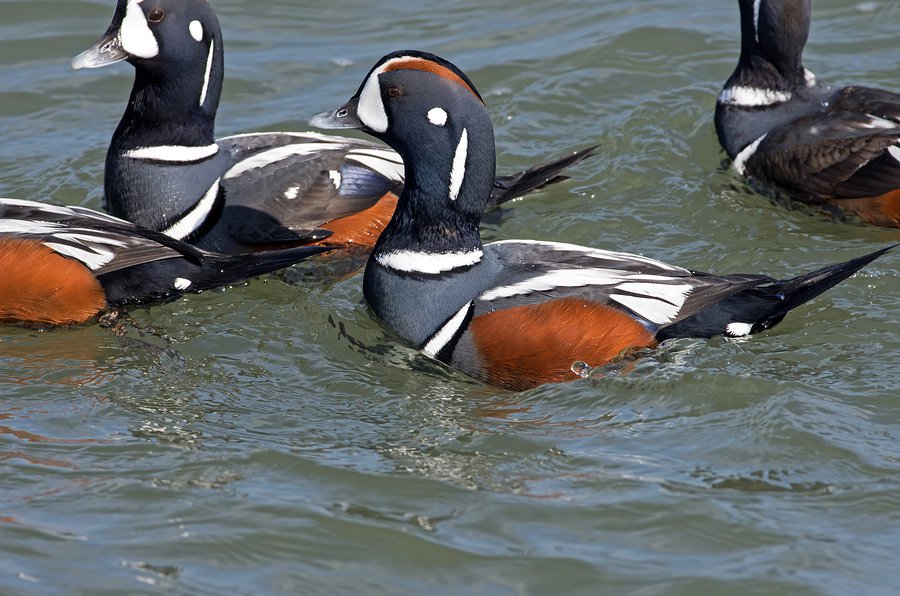
This species is harder to pursue than most here in North America. Only because it has an extremely limited range from Alaska down the coast of British Columbia to parts of Washington. Some are also found in parts of Newfoundland and Labrador.
Drake harlequin ducks have distinctive black, white and striped heads. The neck is black with the body varying with distinctive white, black and grey stripes. Hens are a drab grey or brown. Both sexes have short, light-colored beaks. These diving birds eat a little bit of everything including plants and small insects.
It isn’t often that someone can refer to waterfowl hunting as “extreme,” but it’s a fitting description for some of the lengths some hunters go through to bag ones of these ducks. Kodiak Island in Alaska is place that is usually thought of as a prime spot for big game like bear and blacktail, but it’s considered a prime harlequin duck hunting spot.
Ruddy Duck
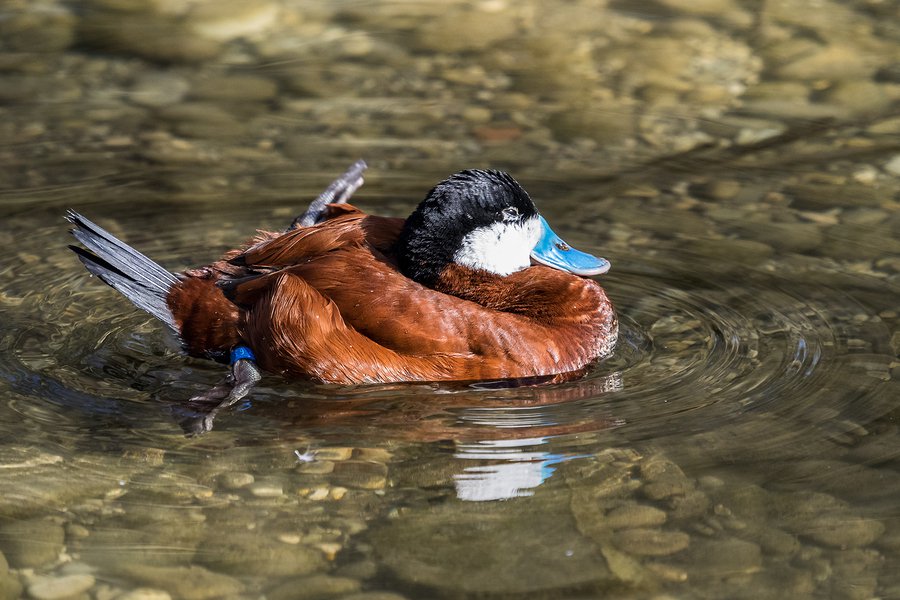
This species, like the northern shoveler, is sometimes classified as a “trash” species. I guess people don’t like ducks with unusually large bills? To be fair, the ruddy duck is unusual looking. Drakes have a black and white head and brown body. But the thing that makes them stand out is the bright blue bill. Females take on a more muted brown and grey appearance with a darker bill.
These ducks can be found throughout much of the United States. They prefer to feed on a variety of aquatic grasses, but they’ll not pass up an opportunity at a tasty aquatic insect, either.
Ruddy ducks are a challenge to hunt for a variety of reasons. One being that they don’t respond well to decoys and manufacturers don’t make any for ruddy ducks anyway. But it also doesn’t help that these birds don’t fly as often as other species. They also have a tendency to fly after right before first light or after last light, meaning odds of taking one are lessened.
Bufflehead Ducks
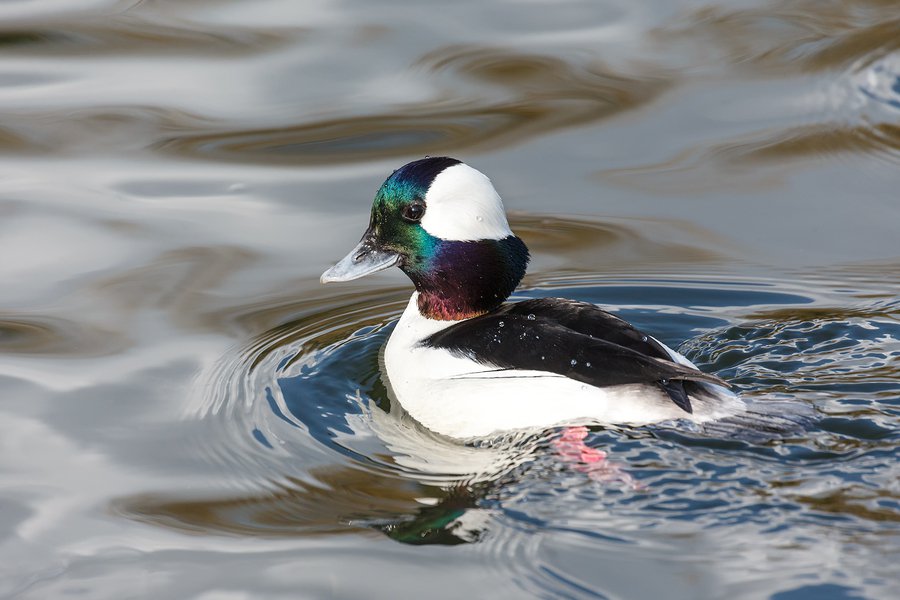
These are extremely small sea ducks that can be found across much of North America at different times of the year. Drakes have a mostly white body with a black back. The head is what catches most people’s eye. Males have a huge white patch that is accentuated with iridescent green, black and purple plumage.
Hens are more subdued with a light grey body and black head. They have a white stripe on their head that makes them easy to identify. Buffleheads are interesting in that they like to nest in trees, usually in the abandoned nests of other birds.
Buffleheads are primarily predators feeding on small aquatic insects and other invertebrates where they live in ocean environments. Those these are small diving ducks, they respond well to decoys for hunters looking to target them.
Common Goldeneye
A subspecies along with the bufflehead, the common goldeneye is slightly larger. Males have a distinctive white patch on their otherwise dark black or green iridescent heads and dark beaks. Their bodies are white and black. The name of these birds comes from the drake’s distinctive eye, which is yellow. Females have a slightly lighter appearance with grey or tan heads and bodies.
Goldeneye are predatory and hunt mollusks, insects and other invertebrates with their short bills. These birds nest in the tundra but can be found all across the United States and Canada at certain times of the year. Like the buffleheads, these ducks like to nest in hollow tree cavities, often they take over old nesting spots of other birds like woodpeckers.
When hunting goldeneye, try to keep your spread small. Unlike many other species, they are also very picky about the decoys they’ll respond to. You’ll need goldeneye specific decoys to bring them in close enough for a shot.
For more outdoor content from Travis Smola, be sure to follow him on Twitter and check out his Geocaching and Outdoors with Travis YouTube channels.
NEXT: THE 12 BEST UPLAND HUNTING GUNS AVAILABLE
WATCH
The post The Great Big American Duck Hunting Species Guide appeared first on Wide Open Spaces.

